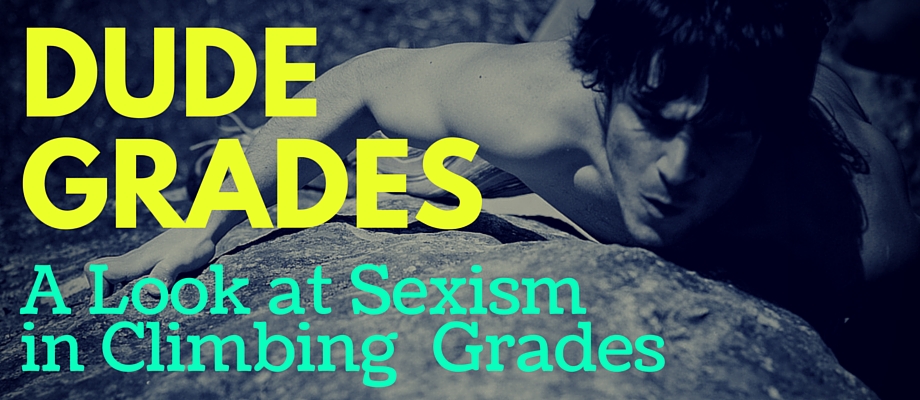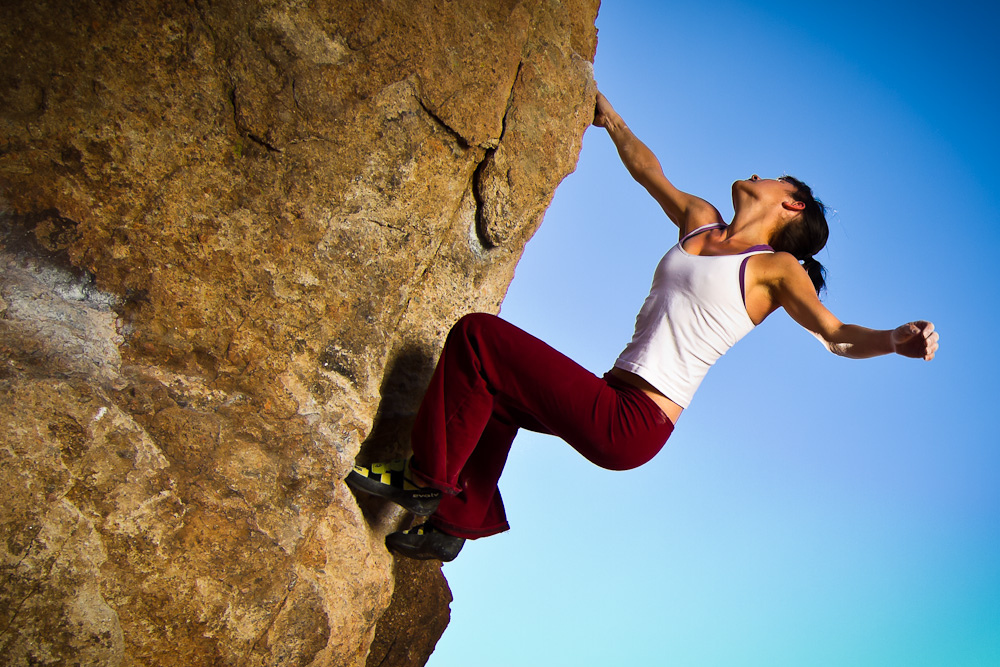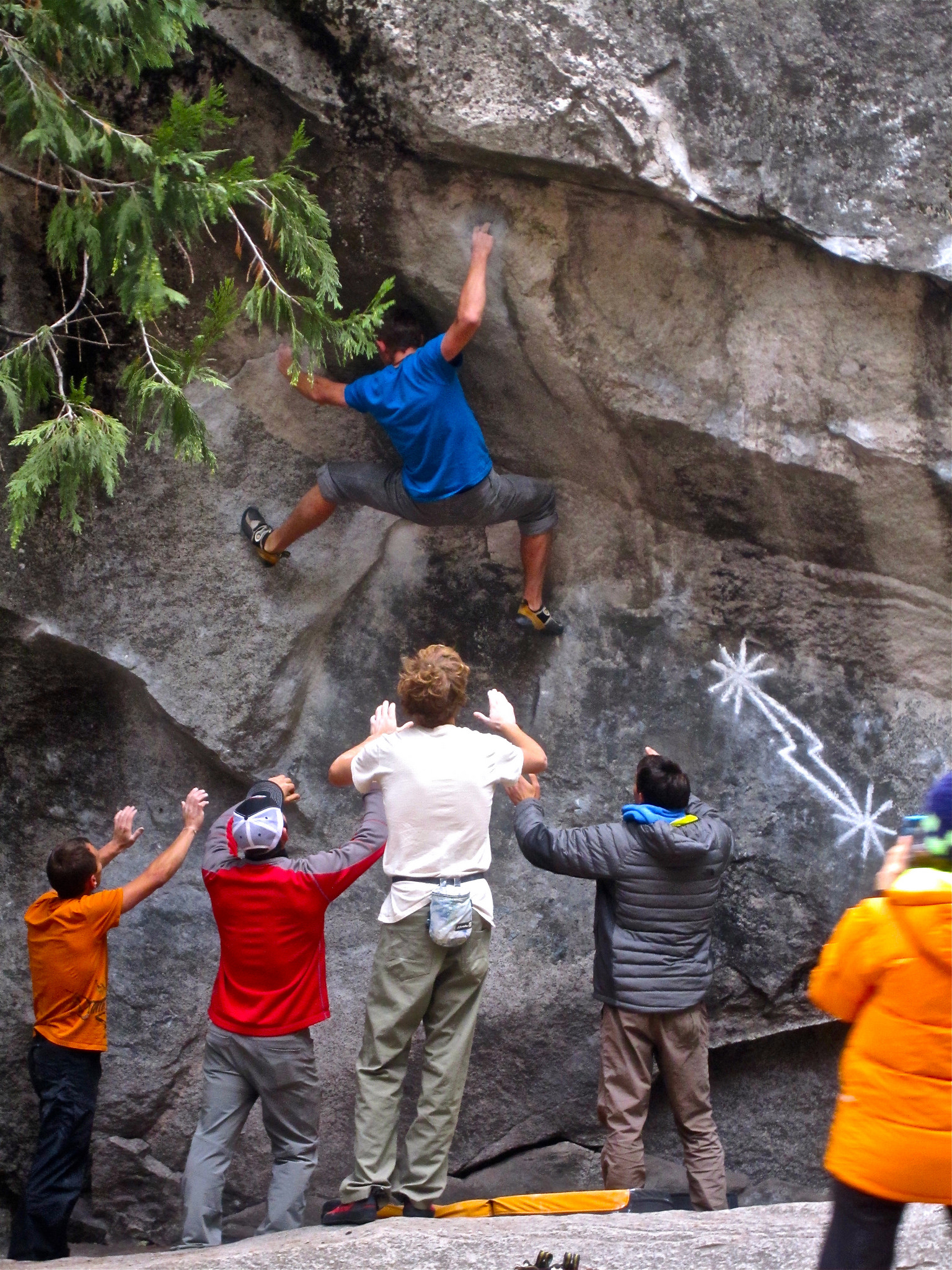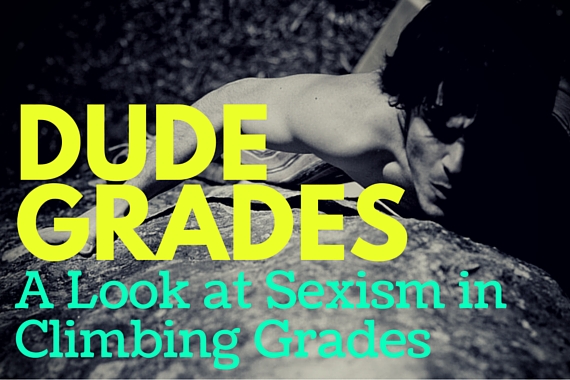
Photo: Pim Horvers
The thoughts or ideas expressed in this article do not necessarily reflect the opinions of Moja Gear. We do, however, support a platform for freedom of expression and open discussion within the climbing community.
When a climb has a rating that applies to more men than women, it has a dude grade. What’s a dude grade? Nearly all dynos are good examples.
In all probability, a man did the first ascent and gave the climb the rating it has today, even if it is rarely repeated by a woman, even a woman who has climbed significantly harder than the grade suggests.
This is the definition of a dude grade:
a grade that reflects the difficulty for some and not others, that applies to more men and less women.
There are an awful lot of them out there. This is because the grading scales—you know, 5.10a and V3—were designed to give us dude grades. The ratings that apply equally well to everyone, those are the accidents, the coincidences, the result of random chance. The Yosemite Decimal System (YDS) and the V-Scale were both created by men for male bodies, leading to grades that don’t work for half the people who use them.
Dude grades aren’t about the experience of any particular person. If a woman feels like the grading systems are a good fit for her, she has my full support. Dude grades are about trends, about the demographics of the group of people who feel that the grades represent their experiences.
The things I say about grades will also resonate with some men, not to mention people who don’t identify as either gender binary. I make generalizations about gender in this short article, but I know that the world is not this simplistic. In looking closely at dude grades, we see how a homogenous group of climbers determined the rating standards that we use, and although the problems roughly trace gender lines, the issue is also about morphology, physiology, and the culture of the climbing community.
With that framing, come along on an autobiographical journey …
I started thinking about dude grades after spending time with an exceptional climber who I’ll call “Dana.” I began to notice how little grades seemed to matter to her. I’m not saying she doesn’t care about grades, because she does. They are every bit as important to her as they are to most climbers. Yet for Dana, grades often don’t capture her experience of climbing, and this is the sense in which they don’t have meaning.
There are V10s she can do, and V5s that continue to be projects after years of effort. I’d never seen such a broad range in someone’s abilities, consistently being shut down on climbs rated far below her limit. Dana is five feet tall, and this physiological fact has a profound impact on her relationship with climbing grades. The V10s she can do have enough holds for her to make the reaches or figure out idiosyncratic Dana-beta, and those V5s that she struggles on, they have long, body-specific movement.
Dana is short, but she is not a physiological anomaly. She is representative of a large group of climbers shorter than, say, 5’5”, most of whom are women. So I ask, what would climbing grades look like if they were determined by women?
Think about your favorite problem or route and then imagine how you would climb it if you were five feet tall. Maybe you already know the answer because this description fits you, you are already shorter than most of the climbers out there. If not, I ask the question knowing that it’s nearly impossible to answer.

Photo: Harsh1.0
Over the years, I’ve learned that I can’t predict Dana’s performance on a climb. Her morphology is so radically different from mine that I’m wrong more often than not. Because of this, I don’t know the extent of the changes that would result, yet I’m certain that there would be a grand reshuffling of the grades in all my climbing guides. For the first time, the grading scales would consistently make sense to women and their bodies.
One reason that dude grades are so prevelant is that the rating standards have always been determined by the morphology of men. Looking back at the history of climbing, it’s not surprising that this is the case. Men created them. There were some badass women climbing in the 1960s and 70s when the standards of the YDS were created, but if you look at their numbers during this influential time, they are a small minority.
Take the initial composition of the Stonemasters, the group of southern California climbers who developed the YDS. All men.

Photo: Mike Penney
Consider the V-Scale, developed in Hueco Tanks in the 80s by John Sherman, another man.
The history of climbing in Yosemite Valley is chronicled in the wonderful film Valley Uprising, but although it covers a timespan of fifty years, you only need one hand to count the women it features. This is not a critique so much as a simple fact: the climbers who developed the grading systems were overwhelmingly male. In developing grading scales that captured their “manly” experience of climbing, they inadvertently made grading scales that fail to capture the experience of non-male climbers.
Related: A Brief History of Rock Climbing
Even today, with more woman climbing than ever, the grading systems continue to be dominated by men. Grades are supposed to be based on a consensus within the climbing community, but this is more of an ideal than a fact.
In practice, grades are initially set by the first ascentionist and then modified through the input of a small group of core climbers in an area. Although there are a number of women participating in this process, the overwhelming majority are male. Besides them, the person with the most influence over grades is the author of the local guidebook. Here too, the gender asymmetry is startling. There are over fourty climbing guides to areas in California, and despite my best efforts, I can only find two with women authors. In a literal sense, climbing grades are written by men.
It’s impossible to know the effects that this has on individual climbers. Even if a woman doesn’t locate a problem with grades specifically, the results can be subtle and unseen. Stepping out of my own experience, the YDS and the V-Scale are often demoralizing to women.
For example, when climbers first walk into the gym, gender is a poor guide to climbing ability. Lots of guys are horrible, lots of women are great, and vice versa. Six months later, however, these same groups come into the gym, and the men are now climbing “harder” than the women. In retrospect, this isn’t surprising. Men created and maintain the rating systems that we use to judge difficulty. I doubt that anyone intended the rating systems to be sexist, but nevertheless, dude grades are ubiquitous.
Related: What’s in a Grade?: How to Approach Climbing Difficulty
We aren’t helpless bystanders in all this. Every time we use the grading systems we’re implicitly supporting dude grades and the sexist rating systems that create them. This is one reason that Ian McIntosh and I avoid grades entirely in the recent bouldering guide to Black Mountain. There’s not a single V3 or V9 in the entire book. In place of grades, we use colors that correspond to grade ranges.
If a dyno feels V5 for one person and V9 for another, why put a single number on it? Instead, we call this problem “yellow,” a color that generally corresponds to a range from V6-V8. Most climbers will find the difficulty to be in this range, while others will think it lies outside these bounds.
Some see this vagueness as a problem, but we see it as a virtue. There is already a broad range in how hard a problem feels, a range that spans across men and women, tall and short, slab climbers and gym rats. The color range reflects this breadth of experience instead of telling people how hard a problem should be.
We must do something, because dude grades are a problem for everyone. We all lose out by using grading systems that only take into account the experiences of half the people who use them. Many of my best climbing partners are men and women who are shorter than me. My heart drops every time one of them gets frustrated because they can’t do a climb that’s within their supposed grade “ability” due to reach. I want to be able to share with them the things I love about climbing, free of gender and morphological bias.
After all, aren’t grades supposed to tell you how hard a climb is whether or not you’re a dude?
Want more climbing content? Get our awesome climbing newsletter, delivered weekly.
Explore more
- The Climb-a-Sutra: More than Just a Sexy Book (NSFW)
- Sexism and Rock Climbing: A Conversation That’s Still Worth Having
- The Proud Misfits of Queer Climbing
- Being Strong and Fragile: A Discussion on Sexism, Racism, Exclusivity, and Privilege in Climbing
- The Dirtbag Privilege
- The Dirtbag Dream, and How it Nearly Ruined Climbing For Me
- Nursery Rhymes, Biomechanics, and Bad Attitudes: Why I Stopped Climbing
- Get daily content updates by Liking us on Facebook
- Our 30+ most popular articles ever
- Top 25 Books for Rock Climbers








